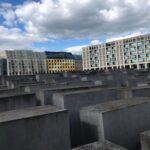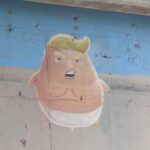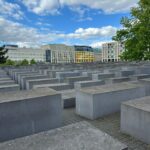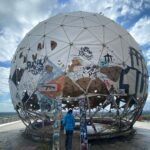 Maya: My favorite part of Berlin was rock climbing—it was so much fun and such a great experience. I also really enjoyed the German Spy Museum, where I got to try a lie detector test. It was fun and interesting to watch my friends do it and ask them questions. Overall, I had an amazing time in Berlin and would definitely come back!
Maya: My favorite part of Berlin was rock climbing—it was so much fun and such a great experience. I also really enjoyed the German Spy Museum, where I got to try a lie detector test. It was fun and interesting to watch my friends do it and ask them questions. Overall, I had an amazing time in Berlin and would definitely come back!
 Gavi:
Gavi:
My takeaway from Berlin is that everyone was affected during the Holocaust. I had heard that other communities were impacted, but I had never fully recognized the extent of it. When I arrived in Berlin, I expected the focus to be only on the Nazis’ impact on the Jews. While we did learn deeply about that, we also learned about many other communities who suffered.
We visited several memorials—not just for the Jewish people, but for many groups affected by the Nazis, both in Berlin and around the world. I don’t remember all the specific names, but I do remember visiting the main Holocaust Memorial and the memorial for people with mental and physical disabilities.
 Lucy:
Lucy:
My favorite part of Berlin was the Holocaust Memorial. What stood out to me most were the words around the sides. I don’t know exactly what they mean, but I interpreted them as expressing what the Jews may have felt throughout the Holocaust. Words like silent and no tears felt very real to me, even though I’ve never experienced anything like that.
 Hailie:
Hailie:
In Berlin, we learned a lot—especially about the Holocaust. We visited the Holocaust Memorial, and it was really interesting. You could interpret the memorial in your own way, which made it even more meaningful. We also learned about other groups who were affected, like the Roma (Gypsies), and what happened to them during that time.
 Charles:
Charles:
Berlin, for me, represented the Holocaust more than any other part of the trip. The Holocaust Memorial with all the concrete blocks was the most meaningful. The way I interpreted the memorial was that each block represented a family that was killed—and the taller the block, the more people in that family who died.
The Spy Museum and the graffiti were super cool too. I especially loved the interactive parts of the museum, like the activity where you had to break into a safe. The graffiti was powerful because of how it came to be—something negative happened in that spot, and it was covered with something creative and positive.
 Seraphina:
Seraphina:
Berlin has a lot of history. Learning about the Romani people and the hatred they faced, along with what happened in certain places, was really interesting. I also got to go rock climbing for the first time in a while, which was so much fun. It was a great way to connect with others and be active while having fun.
 Sammy:
Sammy:
Berlin is a city that has been through a lot. It was the capital of Nazi Germany and was nearly completely destroyed during World War II. Visiting was a super interesting experience because we learned about the Jewish sites within Nazi Germany that survived the Holocaust. We also cleaned Stolpersteine (stumbling stones), which honor the memory of Holocaust victims.
Benny:
I found Berlin to be interesting in many different ways—from the views to the cool shops, there was a lot that looked and felt different to me. The connection I felt at the Holocaust Memorial was powerful and really stayed with me. Every year in early May, I think about the phrase “Never again,” and being in Berlin made those words feel even more meaningful.
Walking to see all the memorial stones and visiting the museums gave me a deeper understanding of the Holocaust and made the message of “Never again” even stronger.

